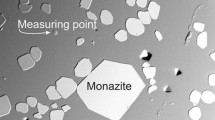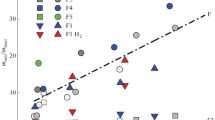Abstract
The solubilities of zircon, rutile, manganocolumbite (MnNb2O6), manganotantalite (MnTa2O6), and the rare earth phosphates LaPO4, GdPO4, and YbPO4 in water-saturated haplogranitic melts containing 0–6 wt.% F were measured at 800° C and 2 kbar. The melt compositions investigated differ only in their F content, the proportions of Na, K, Al, and Si are identical in all experiments. While the solubilities of the rare earth phosphates are independent of F, the solubilities of all other minerals studied strongly increase with F. The TiO2 content of haplogranitic melt in equilibrium with rutile increases linearly from 0.26 wt.% without F to 0.47 wt.% for melts containing 6 wt.% F. Over the same range of F concentrations, the ZrO2 content of the melt in equilibrium with zircon increases with the square of the F content from less than 0.01 wt.% to 0.25 wt.%. The linear increase for rutile and the quadratic relationship for zircon suggest a complexing mechanism. Probably nonbridging oxygen atoms (NBO) expelled from coordination with Al by reaction with F form complexes with Ti and Zr, the ratio of NBO: metal cation being 1:1 for Ti, and 2:1 for Zr. Direct complexing by F is also a possibility. As titanium oxide phases and zircon are major sinks for HFS elements such as Ti, Nb, Ta, Zr, Hf, Th and REE in granites, their increased solubility in the presence of F favors the enrichment of these elements in residual mels. The Nb and Ta content of rutile in granitic pegmatites is due to extended solid solution of rutile with columbite group minerals, such as manganocolumbite and manganotantalite. The solubility of these components also increases with F, MnTa2O6 being more soluble than MnNb2O6. Rutile fractionation could therefore account for the increase in Ta/Nb frequently observed in highly differentiated granites. The solubility of the rare earth phosphates increases strongly from LaPO4 to GdPO4 to YbPO4, which explains the enrichment of heavy rare earth elements in highly evolved granites. In the presence of F, many HFS elements will be highly incompatible in granitic systems. Therefore, in a suite of granitic rocks generated by differentiation from the same source magma, a strong correlation should exist between HFS elements and F. However, because of the influence of F on the solubility of refractory phases such as zircon, a similar correlation could also result from different batches of magma containing different amounts of F equilibrating with the same refractory phase.
Similar content being viewed by others
References
Bailcy DK, MacDonald R (1975) Fluorine and chlorine in peralkaline liquids and the need for magma generation in an open system. Mineral Mag 40:405–414
Černý P (1982) The Tanco pegmatite at Bernic Lake, southeastern Manitoba. In: Černý P (ed) Granitic pegmatites in science and industry. Mincral Assoc Canada Short Course Handbook 8:527–543
Congdon RD, Nash WP (1988) High-fluorinc rhyolite: an eruptive pegmatite magma at the Honeycomb Hills, Utah. Geology 16:1018–1021
Congdon RD, Nash WP (1991) Eruptive pegmatite magma: rhyolite from the Honeycomb Hills, Utah. Am Mineral 76:1261–1278
Dickinson JE, Hess PC (1985) Rutile solubility and titanium coordination in silicate melts. Geochim Cosmochim Acta 49:2289–2296
Dietrich RV (1968) Behavior of zirconium in certain magmas under diverse P-T conditions. Lithos 1:20–29
Edgar AD (1973) Experimental petrology. Clarendon Press, Oxford
Ellison AJG, Hess PC (1988) Peraluminous and peralkaline effects upon “monazite” solubility in high-silica liquids. Eos, Trans. Am Geophys Union 69:498
Farges F, Ponader CW, Brown GE (1991) Structural environments of incompatible elements in silicate glass/melt systems: I. Zirconium at trace levels. Geochim Cosmochim Acta 55:1563–1574
Foord EF (1982) Minerals of tin, titanium, niobium and tantalum in granitic pegmatites. In: Černý P (ed) Granitic pegmatites in science and industry. Mineral Assoc Canada Short Course Handbook 8:187–238
Fourcade S, Allegre CJ (1981) Trace elements behavior in granite genesis: a case study. The calc-alkaline plutonic association from the Querigut Complex (Pyrénécs, France). Contrib Mineral Petrol 76:177–195
Haggerty SE (1976) Opaque mineral oxides in terrestrial igncous rocks. In: Rumble D (ed) Oxide minerals Reviews in Mineralogy vol 3. Mineralogical Society of America, Washington DC, pp Hg 101–300
hanson GN (1978) The application of trace elements to the petrogenesis of igneous rocks of granitic composition. Earth Planet Sci Lett 38:26–43
Keppler H (1991a) The influence of fluorine on the enrichment of high field strength trace elements in the differentiation of granitic rocks. Ber Dtsch Mineral Ges (suppl to: Eur J Mineral) 1991, 1:131
Keppler H (1991b) Influence of fluorine on the solubility of high field strength trace elements in granitic melts. Eos, Trans Am Geophys Union 72, AGU 1991 Fall Meeting Suppl 532–533
Keppler H, Wyllie PJ (1990) Role of fluids in transport and fractionation of uranium and thorium in magmatic processes. Nature 348:531–533
Keppler H, Wyllie PJ (1991) Partitioning of Cu, Sn, Mo, W, U, and Th between melt and aqueous fluid in the systems haplogranite-H2O−HCl and haplogranite-H2O−HF. Contrib Mineral Petrol 109:139–150
London D (1987) Internal differentiation of rare-element pegmatites: effects of boron, phosphorus, and fluorine. Geochim Cosmochim Acta 51:403–420
Mahood G, Hildreth W (1983) Large partition coefficients for trace elements in high-silica rhyolites. Geochim Cosmochim Acta 47:11–30
Manning DAC, Hamilton DL, Henderson CMB, Dempsey MJ (1980) The probable occurence of interstitial Al in hydrous, F-bearing and F-free aluminosilicate melts. Contrib Mineral Petrol 75:257–262
Miller CF, Mittlefehldt DW (1982) Depletion of high rare-earth elements in felsic magmas. Geology 10:129–133
Mittlefehldt DW, Miller CF (1983) Geochemistry of the Sweetwater Wash Pluton, California: implications for “anomalous” trace element behavior during differentiation of felsic magmas. Geochim Cosmochim Acta 47:109–124
Montel JM (1986) Experimental determination of the solubility of Ce-monazite in SiO2−Al2O3−K2O−Na2O melts at 800° C, 1 kbar, under H2O-saturated conditions. Geology 14:659–662
Pichavant M, Herrera JV, Boulmier S, Briqueu L, Joron JL, Juteau M, Marin L, Michard A, Sheppard SMF, Treuil M, Vernet M (1987) The Macusani glasses, SE Peru: evidence of chemical fractionation in peraluminous magmas. In: Mysen BO (ed) Magmatic processes: physicochemical principles. Special Publication 1, Geochemical Society, University Park, Pennsylvania, pp 359–373
Pollard PJ, Pichavant M, Charoy B (1987) Contrasting evolution of fluorine and boron-rich tin systems. Miner Deposita 22:315–321
Ponader CW, Brown GE (1989) Rare earth elements in silicate glass/melt systems: II. Interactions of La, Gd, and Yb with halogens. Geochim Cosmochim Acta 53:2905–2914
Raimbault L, Meyer G, Treuil M (1987) Comportements différenciés de W, Sn, U, Ta, Nb dans quelques complexes granitiques du Massif Central Francais. Bull Minéral 110:591–601
Rapp RP, Watson EB (1986) Monazite solubility and dissolution kinetics: implications for the thorium and light rare earth geochemistry of felsic magmas. Contrib Mineral Petrol 94:304–316
Schaller T, Dingwell DB, Keppler H, Knöller W, Mcrwin L, Sebald A (1992) Fluorine in silicate glasses: a multinuclear nuclear magnetic resonance study. Geochim Cosmochim Acta 56:701–707
Speer JA (1982) Zircon. In: Ribbe PH (ed) Orthosilicates (Reviews in Mineralogy vol 5). Mineralogical Society of America, Washington DC, pp 67–112
Štemprok M (1971) Petrochemical features of tin-bearing granites in the Krusné Hory Mits, Czechoslovakia. Soc Mining Geol Japan, Spec Issue 2 (Proc IMA-IAGOD Meeting): 122–118
Štemprok M (1982) Tin-fluorine relationships in ore-bearing assemblages. In: Evans AM (ed) Metallization associated with acid magmatism. John Wiley, New York, pp 321–337
Štemprok M (1991) Ongonite from Ongon Khairkhan, Mongolia. Mineral Petrol 43:255–273
Treuil M, Joron JL, Jaffrezic H, Villemant B, Calas G (1979) Géochimie des éléments hygromagmatophiles, coefficients de partage minéraux/liquides et propriétés structurales de ces éléments dans les liquìdes magmatiques. Bull Minéral 102:402–409
Tuttle OF, Bowen NL (1958) Origin of granites in the light of experimental studies in the system NaAlSi3O8−KAlSi3O8−SiO2−H2O. Geol Soc Am Mem 74
Watson EB (1979) Zircon saturation in felsic liquids: experimental results and applications to trace element geochemistry. Contrib Mineral Petrol 70:407–419
Watson EB, Harrison TM (1983) Zircon saturation revisited: temperature and composition effects in a variety of crustal magma types. Earth Planet Sci Lett 64:295–304
Waychunas GA, Brown GE, Apted MJ (1986) X-ray K-edge absorption spectra of Fe minerals and model compounds: II. EXAFS. Phys Chem Mineral 13:31–47
Webster JD (1990) Partitioning of F between H2O and CO2 fluids and topaz rhyolite mclt. Contrib Mineral Petrol 104:424–438
Author information
Authors and Affiliations
Rights and permissions
About this article
Cite this article
Keppler, H. Influence of fluorine on the enrichment of high field strength trace elements in granitic rocks. Contr. Mineral. and Petrol. 114, 479–488 (1993). https://doi.org/10.1007/BF00321752
Received:
Accepted:
Issue Date:
DOI: https://doi.org/10.1007/BF00321752




